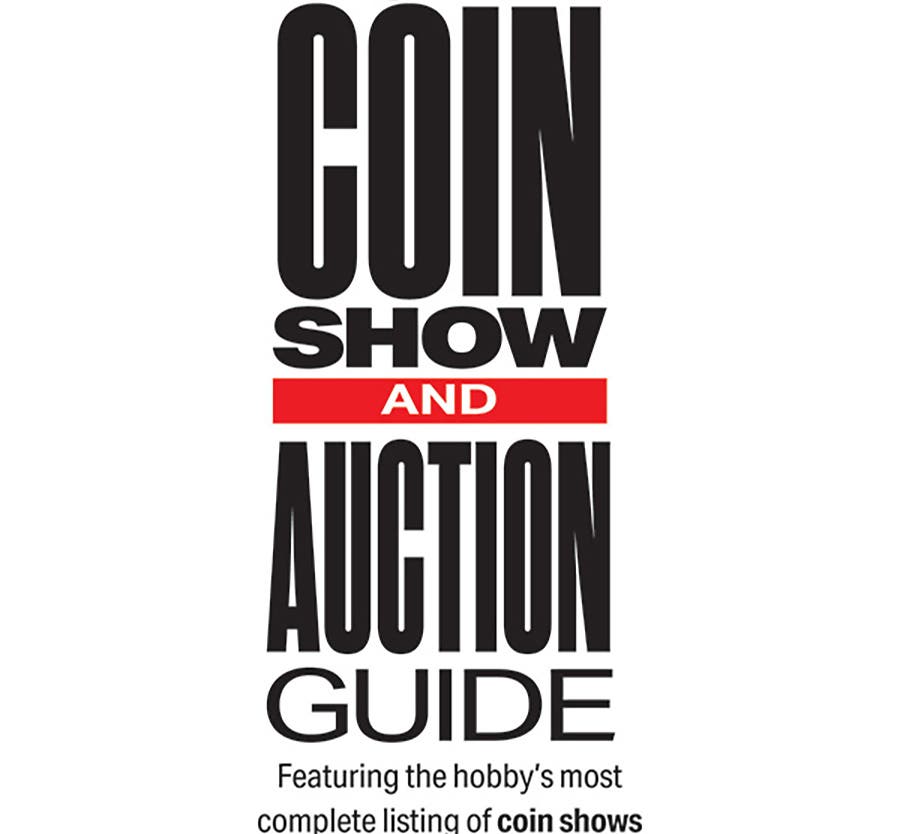Gold legalization big event in 1974
Happy 60th Anniversary to Numismatic News. Working with the paper has afforded me many experiences. I would like to share some with you.
From the Numismatic News 60th Anniversary Special Issue – Clifford Mishler • Iola, Wis.
Happy 60th Anniversary to Numismatic News. Working with the paper has afforded me many experiences. I would like to share some with you.
Picking up where I left off some weeks back in recounting some of the highlight experiences which are readily recalled from my nearly half century of association with Numismatic News, this time out I’m going to cover the period from the mid 1970s through the 1980s. Those were in many respects exciting, ground-breaking years. The hobby community started building upon the Dec. 30, 1974, stroke of midnight commencement of unrestricted gold ownership, and for the hobby community as well from the publishing perspective here in Iola.
This is the point at which my earlier recap terminated.
Where Krause Publications was concerned we were bursting at the seams, so to speak, here in Iola by 1975. The Standard Catalog of World Coins had been launched to resounding success. The first edition released in early 1972 was followed by a second edition in late 1973 and the third in early 1975. This led to the launch of World Coin News in early 1974 as a quarterly, which in quick succession went to monthly, bi-weekly and finally to weekly commencing in May of 1976.
On a parallel basis with this diversification within the numismatic community, the pathway to diversification into other hobby fields had been established with the launch of Old Cars newspaper to serve the automotive collectibles discipline. By the end of the 1980s Krause Publications had become involved as a publisher of periodicals and/or books in well over a score of collectible communities from coins to comic books.
Along the way operations outgrew the thrice expanded office facility Chet had inaugurated on Sept. 17, 1957, being dispersed into four buildings spread around Iola, which were consolidated under one roof in a 20,000 square foot building sited on 16 acres on the east edge of the village in December 1975.
In early 1975 our push for diversification within the numismatic community was further embodied with the release of the first edition of the Standard Catalog of World Paper Money, a partnership having been established with the Munich, Germany, publisher Battenberg Verlag. That firm was headed by Ernst Battenberg, who possessed a contractual publishing arrangement with internationally recognized world paper money authority Albert Pick, author of the new undertaking. Much as publication of the coin catalog had paved the way for publication of a world coins periodical, publication of the paper money catalog in turn created the impetus for acquisition of Bank Note Reporter in 1979, a publication founded in 1973 by the late Grover Criswell.
The nation’s 1976 bicentennial coinage program began rolling from the presses and into circulation in 1975. Coincidentally, in 1976 the $2 bill was placed back in production, this time as a Federal Reserve Note issue displaying a rendering of Trumbull’s Signing of the Declaration of Independence on the back. A plethora of private commemorative issues were available in the marketplace from the likes of the Franklin Mint, the Medallic Art Company and uncounted others. Their market saturating volumes adversely impacted the integrity of the marketplace, which is still felt today.
The big issue of 1977 was incoming President Jimmy Carter’s decision to terminate the participation of public members on the Annual Assay Commission, which was scheduled to meet within days of his inauguration. On March 14, 1980, the President affixed his signature to a law abolishing the function of the Commission, which had met from 1977 to 1980 with the participation of only the statutory members. One of the oldest functioning government bodies with public participation at the time of its termination, the Annual Assay Commission had met without interruption since the first meeting was held on March 20, 1797, as stipulated by statute at the founding of the U.S. Mint in 1792, more than two years after regular production of silver half-dimes, half-dollars and dollars commenced.
The otherwise numismatically quiet year of 1978 was marked consequentially in April with the hiring of 22-year-old David Harper as an editorial assistant on the Numismatic News staff. A collector since age 8 and occasional author of by-lined articles in Coins magazine, editor Harper was an ideal addition to the staff, having graduated from college with dual majors in journalism and economics. Immersed in numismatic journalism for the past 34 years, with the exception of a few months leave of absence taken to run for political office seeking a seat in the Wisconsin Assembly in 1988, he has objectively witnessed, nudged and reported the tempests of the times.
The big development of 1979 was the displacement of the Eisenhower dollar minted to the old silver dollar standard size through 1978, with the ill-fated small Anthony dollar as authorized in 1978. Succeeded in 2000 by the “golden” Sacagawea dollar, it in turn by the Native American issues initiated in 2009, and with the paralleling issuance of the Presidential series in 2007, the many efforts to maintain the new dollars as a circulating offering have proven abject failures. The truth be known, they are certainly little more popular from the collecting perspective, were it not for the various U.S. Mint marketing programs.
The marker event of 1980, numismatically, was the advent of the final Carson City silver dollar hoard sale installment. Authorized by a special law enacted on March 7, 1979, the sale was conducted with a deadline of July 1, 1980. This event closed out a disposition by sale process that had commenced more than seven years earlier, on February 2, 1973. The disposition of this hoard of nearly three million silver dollars discovered in Treasury vaults in Washington, D.C., one might say unknowingly gave birth to the slabbing phenomenon. The process itself presented those who partook of it a “grab bag” result of sorts, as while the prices at which the dollars sold were in keeping with the then current market levels, more than a few proved to be aftermarket quality bargains for lucky recipients.
While they were not gold coins, in a portend of things to come with the reintroduction of commemorative gold coins in 1983 and bullion gold coins in 1986, the U.S. Mint in 1980 undertook the production of gold products, the American Arts Gold Medallions series, which became available to the public for the first time since 1933. The reaction was ho-hum at best; their availability did not cause the slightest ripple in the numismatic marketplace. And, this introduction unfolded on the back side of the silver and gold bullion boom of 1979-80, which broke in early 1980, with the price of gold slipping from a high of $850 on Jan. 21 to under $500 on April 15, with ordering dates for the medallions falling in June and July. The gold market remained soft for 20 years, until bottoming out under $260 in 2001, floating in the range between $255 and $509, until beginning a relatively steady upward climb for the past 10 years.
With the growing diversification of Krause Publications’ publishing ventures, primarily outside of numismatics at the time, inbound mail volume of flowing into the Iola Post Office was building exponentially, that destined to the company being multiples of the daily volume of the rest of the mail addressed to Iola’s 54945 Zip Code. To bring efficiency to the handling of the increased mail volume, in 1980 the United States Post Office assigned a unique Zip Code – 54990 – to Krause Publications, allowing its mail to be processed at the Sectional Center sorting facility in Oshkosh, 55 miles away.
Things were plodding along from a numismatic perspective again in 1981 until the hobby community gathered in New Orleans for the ANA’s 90th anniversary convention. It was there that the news broke that a newly enacted law was going to seriously restrict the holding of collectibles, coins in particular, in IRA and Keogh retirement plans. Coming at a time when a relatively weak market was being buoyed by the investment placing of scarce and rare coins in those plans, this development was greeted with pessimistic foreboding. Faced with adversity, coin dealers banded together with bullion dealers and other tangible asset dealers in 1988 to establish the Industry Council for Tangible Assets as a trade association focused on nurturing a favorable commercial regulatory climate.
But, a Christmas present of sorts entered the picture on Dec. 23, 1981, when the law authorizing the George Washington 250th anniversary commemorative half-dollar for issuance in 1982 was signed by President Reagan. This issue resurrected a lapse of more than a quarter century in the tradition of commemorative coin issues in the U.S., with the exception of the Bicentennial coin issues. This brought to fruition a desire that the News had pushed for editorially throughout the 1960s and 1970s. Unfortunately, the aftermath has not been in keeping with the historical moment and merit of this first offering of the modern era.
The first change of note in the nation’s circulating coinage since the 1965 introduction of clad dimes and quarters (1971 for halves) was implemented in 1982. The copper alloy (bronze; .950 copper and .050 tin and zinc) of the cent, essentially unchanged since 1864, was degraded to copper plated zinc (99.2% zinc with 0.8% copper plating). Intriguingly, this development coincided with the production of large and small date 1982 cents in both versions, a throwback of sorts to the 1960 large and small date cents phenomenon, though the waves were not nearly as high the second time around, although the differential was of similar magnitude.
While the hobby community in 1982 was rejoicing in the return of commemorative coin programs, that satisfaction ultimately turned out to be a mixed blessing. Legislation that became law on July 22, 1982, authorized the minting of coins in 1983 and 1984 in salute to the hosting of the 1984 Los Angeles Summer Olympic Games. With the News taking the lead, the hobby community joined with other interested parties, among them Congressman Frank Annunzio of Illinois, chairman of the House Banking subcommittee on coinage, in forestalling authorization of a 29 coin program and turning the marketing over to a private firm that would skim off the profits. The resulting three coin issue, a pair of silver dollars and a $10 denominated gold piece, each in multi-mintmarked versions, raised more than $73 million to foster the Olympic program.
Within a few years this promising renewal of the commemorative coinage unfortunately fell victim to abuse, as worthy organizations sought and received authorization for offerings of questionable merit to serve their fund-raising desires as opposed to legitimate commemoration. Since 1982 at least one commemorative issue has been forthcoming every year, with the exception of 1985. In 1994 the tally mounted to five issues, totaling seven different coins, each with two mintmarked versions. While only three commemorative series were issued in 1995, the number of coins climbed to 20, with two mintmarked versions each. And, so it has gone, with a true mishmash of offerings.
The year 1983 for the numismatic hobby was a relatively quiet one from the perspective of my nearly 30 years past recall, but not where activities around Krause Publications and Iola were concerned, while there was a building focus on diversification. Having acquired and reconstituted Comics Buyer’s Guide in December, 1982, the publication Goldmine was then acquired early in 1983, followed by the launch of Postcard Collector, publications which respectively served the comic book, record and postcard collecting communities. During the year Krause staffers are estimated to have traveled nearly half a million miles promoting and serving their interest communities and more than a quarter million subscribers combined. Here at home the just 10-year-old Iola Old Car Show had grown to an event that attracted 80,000 visitors and grossed $275,000, with $112,000 in profits being divided up among the local charities providing the volunteers to staff the event.
Commercial activity in the numismatic field struggled throughout the 1980s, with circulations of all periodicals dropping fairly steadily and dramatically, following the speculative boom years of 1978 to 1982. The Krause Coin of The Year award was launched in 1984 by World Coin News, which recognized the six most outstanding world-wide coin issues for the year 1982, with the striking Elizabeth Jones designed George Washington commemorative pulling down top honors. The 1984 ANA 93rd anniversary convention in Detroit extended a personal highlight, as it was there that I became the surprised recipient of the Farran Zerbe Memorial Award for service to the ANA and the hobby community.
While President Ronald Reagan issued an executive order barring the import of South African Krugerrand gold bullion coins on Oct. 11, things had actually started looking up in 1985 with the authorization of the 1986 Statue of Liberty Centennial commemorative series on July 9, which included a $5 denominated gold issue. Then, on Dec. 17, 1985, the Gold Bullion Act became law, directing the U.S. Mint to initiate the American Eagle Gold Bullion Coin series in 1986, which was followed by introduction of the Silver Eagle bullion coin, resurrecting Weinman’s Liberty Walking half dollar design used from 1916 through 1947.
The year also witnessed a visit to Iola by U.S. Treasurer Katherine Ortega, who joined a building line of government officials – the first were U.S. Mint director Eva Adams and Royal Canadian Mint master Norval Parker, who visited on the same June day in 1964 – who have made the trip to present their cases over the past five decades.
The year 1986 was another relatively quiet one for Krause Publications and the coin collecting community. During the year the Treasury Department did announce that Fort Worth, Texas, had been selected as the site of a Bureau of Engraving and Printing western currency manufacturing site, which was to begin production of U.S. paper money in 1990. The ANA convention came to Milwaukee, with the company organizing the largest ever display of Wisconsin numismatic collectibles ... 140 cases of National Bank Note and obsolete currency, merchant tokens and store cards, Civil War tokens and merchant scrip issues ... plus Chet’s own Wisconsin made 1922 Kissel touring car, accompanied by a National Bank Note signed by maker William Kissel of Hartford.
As 1986 was closing, at the annual employee Christmas party, the staff learned that with the coming of the new year there would be a new company president ... Chet was passing operational responsibilities to newcomer Don Nicolay. Nicolay brought an aggressive sales and growth strategy to the company. The growth strategy was initially boosted by the 1987 mid-year acquisition of Gun List, a shopper presented in the style of the cornerstone of Krause Publications, Numismatic News, which had been nurtured to life nearly 35 years before. From the publishing perspective, activity in the numismatic field was rather lethargic, but the sports card field was booming.
In 1988 a pair of periodical acquisitions, a pair of start-ups and an aggressive move into book publishing beyond the scope of the established Standard Catalog lineup got underway, as the existing titles were split off from the niche hobby publishing areas into a distinct book publishing division. That division eventually grew to embrace in excess of 800 active titles through acquisition and internal development. The acquisitions found the company venturing off into a non-collecting hobby aspect, that of sportsmen, with Turkey Hunter and Trapper & Predator Caller. The start-ups were a periodical price guide in the sports card field and Toy Shop, a clone of Gun List and the original News format. And the final touches were being applied to a book title which had been nearly a decade in the making -- the hefty tome by Jim Haxby, Standard Catalog of U.S. Obsolete Bank Notes – that would see the light of day in early 1989.
The year 1988 was also a landmark occasion for the employees of Krause Publications, it being announced in October that a newly created Employee Stock Ownership Plan would, over the years, through a form of profit sharing transfer the value of ownership in the company from Chet Krause to the employees. During the year overall employment had climbed past the 200 mark for the first time. The company and its employees were on the cusp of unprecedented growth and change which would unfold over the coming two years.
In 1989 Krause Publications dipped its toes into show sponsorship waters, with acquisition of the Chicago International Coin Fair to which it had been informally tied since its launch in 1976, its first solo production being the 15th annual event in 1990. This acquisition was seen as a fitting marketing adjunct to the company’s publishing efforts in the world coin and paper money fields. This venture was to be followed in years to come by development of the Chicago Paper Money Exposition and acquisition of the Mid-America Coin Expo, along with events in the sports memorabilia, limited edition collectibles, cutlery and antiques hobby niches, not to mention its ongoing supportive involvement in the Iola Old Car Show, which in 1984 had begun developing separate from Krause Publications as a non-profit with an independent staff.
For Krause Publications, 1990 was an interesting year. Chet Krause got it off to a sparkling start by being named Wisconsin Small Business Person of the Year under the umbrella of the Small Business Administration. At the Milwaukee banquet where he received the recognition, with Wisconsin Governor Tommy Thompson as the keynote speaker, he was quick to credit his success to the staff in Iola. He subsequently observed; “From 1987 through 1990, Krause publications saw its revenues grow by 300 percent, and its work force by almost 100. During that time Krause got into several new, profitable ventures ... “ At the ANA convention at Seattle in August, Chet’s hobby peers honored his induction into the Numismatic Hall of Fame.
An unexpected surprise unfolded that summer when president Don Nicolay announced his resignation, whereupon Chet reclaimed the job of president on a temporary basis. Nicolay’s aggressive sales and growth strategy during the course of the year resulted in the introduction of several new titles to the still hot sports collectibles division, including the pioneering Fantasy Baseball title, and the acquisition of an agricultural title, Agri-View, which joined Rural Builder in a new targeted business publishing niche. During Don’s four-year tenure revenue growth averaged about 30 percent annually, climbing from just shy of $13 million in 1986, its highest grossing year ever, to nearly $45 million for 1990.
At the annual Krause Publications Christmas party in December, as at that of four years earlier, Chet announced that a new president would be in the lead chair as of January 2, 1991. While this announcement, like the earlier one, was not necessarily expected, this was a handoff that employees would have likely presumed and by indications appreciated. Having declined the elevation in 1986, I had agreed to it this time, making it clear that I was not signing on board for the long haul, but rather in a transitional context.
My tenure ended up being nine years, with Roger Case taking over as of Jan. 2, 2000, he having been a 1988 hire. Coming from Miles City, Mont., he possessed 15 years of newspaper publishing experience in small communities, bolstered by a non-coin collecting interest, providing a good fit for heading up the numismatic division and growing with the development of our diverse small hobby communities.
Having shouldered the presidential role, starting in 1991, with the continuing growth of the company -- by the time I stepped down we were approaching $100 million in annual revenues and 500 employees – my involvement in day to day numismatic publishing and coin hobby political activities lessened markedly. While I continued to attend numismatic events as a collector, I largely divorced myself from keeping tabs on the goings on of the next 10 years.
For the next 12 to 15 years, my hobby related involvements retreated significantly, with the exception of ongoing involvement in perpetuating ideals embodied by the Numismatic Ambassador Award program and participating in the annual ANA conventions. There were other exceptions, of course, as I accepted election to the governing boards of the Higgins Museum of National Banking in Okoboji, Iowa, in 1991, and the American Numismatic Society in New York City in 1997, in which year I was also pleased to be accorded the ANA’s Lifetime Achievement Award.
An exciting and rewarding 28 years were in the books, so to speak, with few if any regrets along the way. What I’ve endeavored to set forth in this and the prior column, embracing the years 1963 through 1974, are recollections from my passage through the hobby and my publishing involvement that have readily bubbled to the surface. There are many more that could be dug out that might be of interest to readers, particularly those drawn from hobby community exposures ... perhaps on some future occasion.
More Coin Collecting Resources:
• Subscribe to our Coin Price Guide, buy Coin Books & Coin Folders and join the NumisMaster VIP Program









